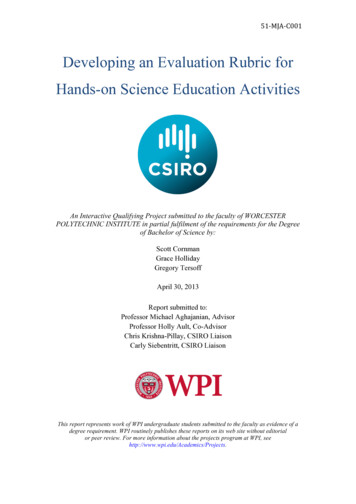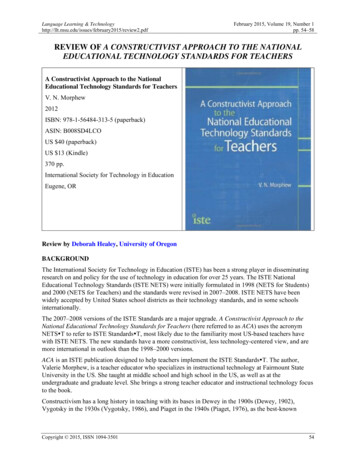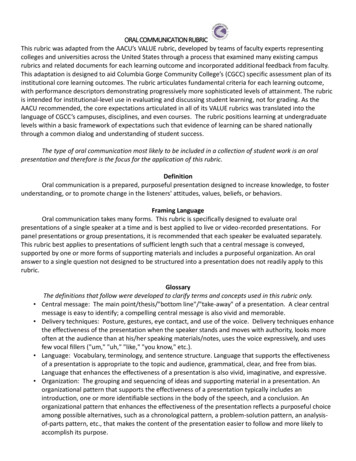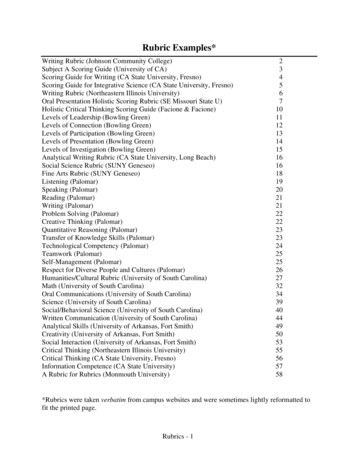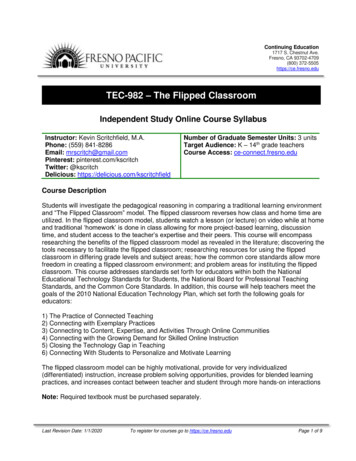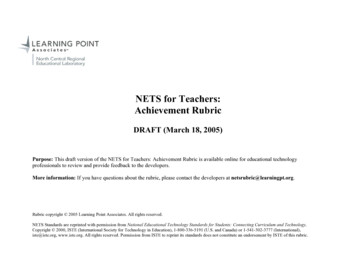
Transcription
NETS for Teachers:Achievement RubricDRAFT (March 18, 2005)Purpose: This draft version of the NETS for Teachers: Achievement Rubric is available online for educational technologyprofessionals to review and provide feedback to the developers.More information: If you have questions about the rubric, please contact the developers at netsrubric@learningpt.org.Rubric copyright 2005 Learning Point Associates. All rights reserved.NETS Standards are reprinted with permission from National Educational Technology Standards for Students: Connecting Curriculum and Technology,Copyright 2000, ISTE (International Society for Technology in Education), 1-800-336-5191 (U.S. and Canada) or 1-541-302-3777 (International),iste@iste.org, www.iste.org. All rights reserved. Permission from ISTE to reprint its standards does not constitute an endorsement by ISTE of this rubric.
NETS for Teachers: Achievement RubricNETS for Teachers IA. Demonstrate knowledge,skills, and understanding ofconcepts related totechnology (as described inthe ISTE NationalEducational TechnologyStandards for Students).Learning Point AssociatesNoviceBasicProficientAdvancedA1. Teachers identifyfunctions of the computerdescribing access, control,and use of classroomcomputer hardware includinginput devices (e.g., keyboard,track-pad, and mouse), outputdevices (e.g., monitors andprinters), and internal andexternal storage options (e.g.,hard drive, floppy drive,portable drive, compactdisks).A1. Teachers identify anduse common peripheraldevices found in theclassroom (e.g., printer,monitor, scanner, digitalcamera, video projector) anddescribe how to locateinformation on uses, care,and basic maintenance ofthese classroom technologyresources.A1. Teachers compare andevaluate hardwarecomponents and softwareresources used to provideaccess to local areanetworked curriculummaterials, Web resources, andmultimedia resources (e.g.,computer system, printers,monitors, video projectors,external drives, scanners,digital cameras, speakers,browsers, plug-ins, mediaplayers, movie, photo, andmusic utilities).A1. Teachers know how toconnect and use commonperipherals, identify anddescribe uses, advantages,and challenges for advancedresources (e.g., digital probes,artificial intelligence, virtualreality, simulations) andadvanced network resources(e.g., compressed video,video server, videoconferencing software, andWeb casting).A2. Teachers describegeneral uses of computerbased curriculum materials;applications programs (e.g.,word processor, drawingprogram, presentationsoftware, e-mail); onlinereference materials; Internetbrowser; and schooladministrative reportingsoftware.A2. Teachers describeteacher and student uses forapplication software;network-based curriculumresources; spreadsheets,database, and e-mailapplication software; andcommon utilities software.A2. Teachers identify,describe, and solve simplehardware, software, andnetworking problems thatoccur during everyday useand know how to clearlycommunicate more serioustechnical difficulties, need forsupport, or technicalassistance to appropriatetechnical staff.A2. Teachers know how toaccess and use help desks,online help, and userdocumentation to recognizecommon hardware orsoftware and networkproblems.A3. Teachers identifygraphical user interface (GUI)functions represented bymenus, symbols, and iconscommonly used to navigateand control computer- andInternet-based curriculumsoftware; and identifydrawing, editing, menuselection, or other optionswithin a program.A3. Teachers identify andapply GUI menu options toselect, create, edit, manageand maintain computer fileson a hard drive, floppy disk,or networked location.A3. Teachers recognize,manage, and maintaincomputer files in a variety ofdifferent media and formatson a hard drive, network, andWeb location.A3. Teachers selectadvanced utilities (e.g.,compression, antivirus, spamblocker) based on specificsystem needs.NETS for Teachers: Achievement Rubric—1
NETS for Teachers: Achievement RubricB. Demonstrate continualgrowth in technologyknowledge and skills to stayabreast of current andemerging technologies.NETS for Teachers IIB. Teachers select school,district, university, or onlineprofessional developmentopportunities based on theISTE National EducationalTechnology Standards forTeachers and develop a planfor their own professionalgrowth.NoviceB. Teachers select and usecorrect terminology todescribe functions of currentand emerging hardware,software, and network-relatedresources used for classroomsettings.B. Teachers researchemerging hardware, software,and network-related resourcesreported by current news,periodicals, and Internetresources, and at professionalmeetings and involvestudents in investigatingand assessing possibleeffects of evolvingtechnologies on educationand jobs.BasicProficientB. Teachers identifyemerging technologyresources and formulatestrategies for acquisitionand use of emergingtechnologies with aconvincing degree ofeducational potential.AdvancedA. Design developmentallyappropriate learningopportunities that applytechnology-enhancedinstructional strategies tosupport the diverse needs oflearners.A. Teachers identifydevelopmentally appropriatetechnology-based learningresources that address contentstandards, technologystandards, and individuallearner needs.A. Teachers select and useappropriate technologyresources to enhanceindividual student academicperformance and technologyliteracy.A. Teachers know how toplan and implementtechnology-based learningactivities that promotestudent engagement inanalysis, synthesis,interpretation, and creation oforiginal products.A. Teachers know how toapply information andcommunication technologyto gather and analyze datathat will drive planning oflearning opportunities thatapply technology-enhancedinstructional strategies tosupport the diverse needs oflearners.B. Apply current research onteaching and learning withtechnology when planninglearning environments andexperiences.B. Teachers identifyresearch and learningtheories and describe theirapplication to teaching andlearning with technology.B. Teachers predictpotential of specifictechnology, software,teaching strategies, orenvironmental factors tocontribute positively tostudent learning based onestablished educationalresearch.B. Teachers use research onteaching and learning withtechnology to inform theirplanning of technologybased learning environmentsand experiences.B. Teachers identify ordescribe how involvement inor results of classroom-basedaction research, case studies,surveys, focus groups, orexperimental studies oftechnology-based learningenvironments andexperiences changed oraffirmed their planning,teaching, or assessmentpractices.Learning Point AssociatesNETS for Teachers: Achievement Rubric—2
NETS for Teachers: Achievement RubricC. Identify and locatetechnology resources andevaluate them for accuracyand suitability.C. Teachers select technologyresources based on alignmentof content to curriculum,developmental level,accuracy, and suitability tothe student needs.C. Teachers describe criteriafor evaluation of a variety oftechnology resources foraccuracy, appropriateness,comprehensiveness, and bias.C. Teachers identifyactivities designed to engagestudents in researching avariety of technologyresources and evaluating theresources for accuracy,appropriateness,comprehensiveness, and bias.C. Teachers evaluate plansfor managing availabletechnology resources,providing equitable access forall students, and improvingstudent academicachievement and technologyliteracy across content areas.D. Plan for the managementof technology resourceswithin the context of learningactivities.D. Teachers identifyresource managementstrategies that are appropriateto student developmentallevels.D. Teachers develop andimplement plans thatfacilitate student-centeredlearning activities in whichstudents apply curriculumrelated technology resources.D. Teachers describedevelopment process formanaging availabletechnology resources tofacilitate improvement ofstudent academicachievement and technologyliteracy.D. Teachers engage inongoing planning of lessonsequences that effectivelyintegrate technologyresources and are consistentwith current best practices forintegrating the learning ofsubject matter and studenttechnology standards.E. Plan strategies to managestudent learning in atechnology-enhancedenvironment.E. Teachers identifytechnology managementstrategies.E. Teachers know how toplan student-centeredlearning activities thatfacilitate access to technologyresources for all students.E. Teachers associatetechnology managementissues and related solutionsto inform planning oftechnology, enhancedteaching, learning, andcommunications activities.E. Teachers explain benefitsand limitations ofcollaborative planning formanagement of technologybased learning activities.BasicProficientAdvancedA. Teachers align learningactivities with curriculumstandards and identifyrelated technologyresources to support contentlearning.A. Teachers know how tofacilitate learningexperiences that integrateboth content and technologystandards to improve studentacademic achievement andtechnology literacy.NETS for Teachers IIIA. Facilitate technologyenhanced experiences thataddress content standards andstudent technology standards.Learning Point AssociatesNoviceA. Teachers identifytechnology-enhancedexperiences related to thesubject area.A. Teachers know how tofacilitate learningexperiences that integratetechnology to improvestudent academicachievement and technologyliteracy by connectingcurriculum standards withtechnology standards acrosssubject areas and gradelevels.NETS for Teachers: Achievement Rubric—3
NETS for Teachers: Achievement RubricB. Use technology to supportlearner-centered strategiesthat address the diverse needsof students.B. Teachers select and usetechnology resources andcontent-specific tools (e.g.,simulations, mathematicalsoftware, Web tools) thatsupport learner-centeredstrategies and address thediverse needs of learners.B. Teachers apply strategiesfor engaging students withdiverse needs, using a varietyof instructional and groupingstrategies (e.g., whole group,collaborative, individualized)and supporting individuallearner needs with specializedtechnology resources forcontent learning.B. Teachers know how to usea variety of instructional andgrouping strategies (e.g.,whole group, collaborative,individualized) to supportlearner-centered activities thatintegrate technology resourcesand engage students withdiverse needs in learning acrosscontent areas and grade levels.C. Apply technology toC. Teachers identifydevelop students’ higher order activities in which theirstudents can apply higherskills and creativity.order thinking skills.C. Teachers select and usetechnology resources tofacilitate student use ofhigher order thinking skills(e.g., problem solving, criticalthinking, informed decisionmaking, knowledgeconstruction, creativity)through team andindividual activities.C. Teachers identifystrategies for student use oftechnology designed tofacilitate higher orderthinking skills (e.g., problemsolving, critical thinking,informed decision making,knowledge construction, andcreativity) focused oncurriculum-related goals.C. Teachers know how toimplement learning activitiesthat apply technology topromote studentengagement in analysis,synthesis, interpretation,and creation of originalproducts.D. Manage student learningactivities in a technologyenhanced environment.D. Teachers managestrategies for use, care, andsharing of technologyresources to students.D. Teachers know how toselect and use technologyresources that develop studentcontent area knowledge andtechnology literacy.D. Teachers apply technologybased strategies to collectresources that develop contentarea knowledge andtechnology literacy.D. Teachers facilitate studentuse of technology to addresssocial needs and culturalidentity and promoteinteraction with the globalcommunity.NETS for Teachers IVNoviceBasicProficientAdvancedA. Apply technology inassessing student learning ofsubject matter using a varietyof assessment techniques.A. Teachers applytechnology for recordkeeping resources for studentgrades and for developingassessment resources suchtests and rubrics.A. Teachers evaluatespecialized software andapplications to collect,analyze, and report data;create graphs of class andindividual performance data;identify areas of individualstudent strengths andweaknesses in content-arealearning; and use results toimprove teaching strategies.A. Teachers collect, analyze,and report data on studentperformance from multiplemeasures over time, and applystrategies for use of data toimprove planning,instruction, andmanagement.Learning Point AssociatesB. Teachers identify and usegrade-level appropriatecontent resources usingtechnology as a mode ofpresentation.A. Teachers select and usespecialized software (e.g.,electronic gradebooks,assessment software, checksheets, performance profiler,performance rubrics) tocollect and report data onstudent learning in thecontent areas.NETS for Teachers: Achievement Rubric—4
NETS for Teachers: Achievement RubricB. use technology resourcesto collect and analyze data,interpret results, andcommunicate findings toimprove instructional practiceand maximize studentlearning.B. Teachers use technologyresources to collect andanalyze student performancedata from a variety of resources,identify strengths and areas ofweakness, and adjust teaching toimprove student learning.B. Teachers know how to usespecialized software (e.g.,electronic gradebooks,assessment software, checksheets, performance profiler,performance rubrics) to collectdata on student learning.B. Teachers know how toanalyze, interpret, represent,and communicate results fromspecialized software regardingstudent content learning.B. Teachers know how to useresults of analysis to informplanning for instructionalpractice across content areasand to maximize studentlearning.C. Apply multiple methods ofevaluation to determinestudents’ appropriate use oftechnology resources forlearning, communication, andproductivity.B. Teachers identifystrategies for assessingstudents’ uses of technologyresources.C. Teachers identify multiplemeasures for assessingspecific applications oftechnology resources.C. Teachers design formativeand summative assessmentstrategies for evaluatingappropriate student use oftechnology for content-arealearning, communication, andproductivity.C. Teachers know how toguide students in applyingself-assessment and peerassessment strategies toevaluate a variety of technologyproducts and the processes usedto create those products acrosscontent areas and grade levels(e.g., electronic portfolios).NETS for Teachers VNoviceBasicA. Use technology resourcesto engage in ongoingprofessional development andlifelong learning.A. Teachers know commonuses of information andcommunication technology indaily life, some advantagesand disadvantages oftechnology use, and canidentify technology uses thatsupport lifelong learning,collaboration, personalpursuits, and productivity.A. Teachers design a plan,based on self-assessment, fortheir own professionalgrowth to stay abreast of newand emerging technologyresources that supportenhanced learning for PK–12students.A. Teachers identify andengage in technology-basedopportunities forprofessional education andlifelong learning includinguse of distance education.A. Teachers identifyemerging technologies thatcould support ongoingprofessional developmentand lifelong learning, suchas virtual collaborations withpeers and experts, anddevelop plans for long-termprofessional growth supportedby emerging technologies.B. Continually evaluate andreflect on professionalpractice to make informeddecisions regarding the use oftechnology in support ofstudent learning.B. Teachers know how tonavigate the Web and usetechnology resources such asCD-ROMs (reference oreducational software) andcommon databases (librarycatalogs, online archives) toinform decisions regardingthe use of technology tosupport student learning.B. Teachers apply onlineand other resources tofacilitate higher order andcomplex thinking skills,including problem solving,critical thinking, informeddecision making, knowledgeconstruction, and creativitysupport problem solving andrelated decision making formaximizing student learning.B. Teachers know how toconduct advanced Internetsearches using Boolean logicand other advanced searchstrategies; and how toevaluate information from avariety of sources to informdecisions regarding the use oftechnology in support ofstudent learning.B. Teachers know how tolocate, select, and useadvanced technologyresources such as expertsystems, intelligent agents,and real-world models andsimulations to informdecisions regarding the use oftechnology in support ofstudent learning.Learning Point AssociatesProficientAdvancedNETS for Teachers: Achievement Rubric—5
NETS for Teachers: Achievement RubricC. Apply technology toincrease productivity.C. Teachers know how tocreate, retrieve, save, use spellcheck and edit wordprocessing documents,spreadsheets, andpresentations.C. Teachers know how to usecommon software featuressuch as menus and toolbars toformat (i.e., grammar check,thesaurus, etc.) wordprocessing documents,spreadsheets, andpresentations.C. Teachers know how todesign, create, and populatea database and performqueries to process data andreport results inform decisionsregarding the use oftechnology in support ofstudent learning.C. Teachers know how toformulate a hypothesis orresearch question regardingthe use of technology insupport of student learning,and design, create, andpopulate a database to processdata and report results.D. use technology tocommunicate and collaboratewith peers, parents, and thelarger community in order tonurture student learning.D. Teachers know how tomanipulate pictures, images,and charts in word processingdocuments, spreadsheets, andpresentations designed tocommunicate with peers,parents, and the largercommunity and nurturestudent learning.D. Teachers identify and usecommon software andutilities used to create, open,and edit pictures, images, andcharts for use in models,publications, and otherprofessional works in wordprocessing documents,spreadsheets, andpresentations to developdocuments that effectivelycommunicate with peers,parents, and the largercommunity and to nurturestudent learning.D. Teachers describe andapply advanced softwarefeatures (e.g., style sheets,mail merge, slide master, etc.)templates and styles toimprove the appearance ofword processing documents,spreadsheets, andpresentations used incommunications with parents,professional colleagues,school administrativeleadership, and others.D. Teachers know how toread, send, and manageelectronic messages anddistribution lists; and how touse advanced multimediaauthoring tools to plan,create, and edit models,publications, and otherprofessional works developedin collaboration with peers tocommunicate with peers,parents, and the largercommunity in order to nurturestudent learning.NETS for Teachers VINoviceBasicProficientAdvancedA. Teachers describe contentof acceptable use policydesigned to address issuesrelated to legal and ethical useof information andcommunication technologyfor the school and classroom(e.g., privacy, security,copyright, file-sharing,plagiarism).A. Teachers discuss issuesrelated to legal and ethicaluse of information andcommunication technology(e.g., privacy, security,copyright, file-sharing,plagiarism), and identifystrategies for implementingacceptable use policies in theclassroom and school.A. Teachers discuss thecosts and consequences ofillegal and unethical use ofinformation and computertechnology (e.g., hacking,spamming, consumer fraud,virus setting), theimplications of emergingtechnologies for acceptableuse policies, and theimportance of following theguidelines for acceptableuse.A. Model and teach legal andethical practice related totechnology use.Learning Point AssociatesA. Teachers identify legaland ethical issues related touse of information andcommunication technology(e.g., privacy, security,copyright, file-sharing,plagiarism).NETS for Teachers: Achievement Rubric—6
NETS for Teachers: Achievement RubricB. Apply technologyresources to enable andempower learners withdiverse backgrounds,characteristics, and abilities.B. Teachers identify titles orlocations of software andweb resources that supportcommunication,collaboration, personalproductivity, and lifelonglearning for all students.B. Teachers discuss how thedigital divide affects studentlearning and how informationand communicationtechnology can supportcollaboration, personalproductivity, and lifelonglearning for all students.B. Teachers know how toapply technology resources inthe school to help close thedigital divide and discuss howinformation andcommunication technologycan support collaboration,personal productivity, andlifelong learning for allstudents.B. Teachers know currenttrends in information andcommunication technologyand discuss how emergingtechnologies could help closethe digital divide and supportcollaboration, personalproductivity, and lifelonglearning for all students.C. Identify and usetechnology resources thataffirm diversityC. Teachers identifytechnology resources andactivities that help childrendevelop accepting attitudestoward students of differentbackgrounds, races, religions,or national origins.C. Teachers describegrouping strategies andtechnology enhanced globalresources to help studentsrecognize positivecharacteristics and likenessesamong people across theglobe.C. Teachers know how tofacilitate students’ use oftechnology that addressestheir social needs and culturalidentity and promotes theirinteraction in the globalcommunity.C. Teachers evaluateaccuracy, relevance,appropriateness,comprehensiveness, andbias of electronic resourceswhen selecting technologybased materials or Web sitesfor use by students.D. Promote safe and healthyuse of technology resources.D. Teachers identify healthand safety issues relating touse of information andcommunication technology(e.g., electrical wires, rollingchairs, eye strain, poorposture).D. Teachers model andidentify safe and responsibleclassroom procedures toavoid health or safety risks,and post them as appropriatein the classroom.D. Teachers identify andenforce classroomprocedures that guidestudents’ safe and healthy useof technologyD. Teachers identify andadvocate for technologyresources to benefit allstudents and specifictechnology resources forstudents with special needs.E. Teachers exhibitawareness of guidelines forlegal and professionalresponsibilities for studentsneeding assistive technology.E. Teachers arrange forequitable access toappropriate technologyresources that enable studentsto engage successfully inlearning activities within theclassroom.E. Teachers advocate forequitable access totechnology for all students intheir schools, communities,and homes.E. Facilitate equitable access E. Teachers identify issuesto technology resources for all related to equitable access totechnology in school,students.community, and homeenvironments for all students.Learning Point AssociatesNETS for Teachers: Achievement Rubric—7
NETS for Teachers: Achievement Rubric Learning Point Associates NETS for Teachers: Achievement Rubric—1 NETS for Teachers I Novice Basic Proficient Advanced A. Demonstrate knowledge, skills, and understanding of concepts related to technology (as described in the ISTE National Educational Technology Standards for Students). A1.
